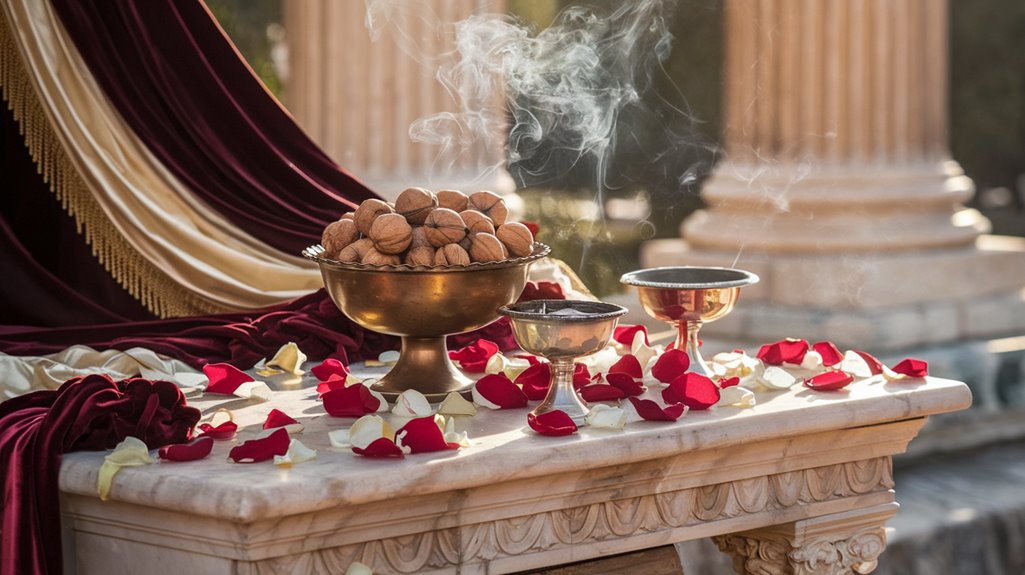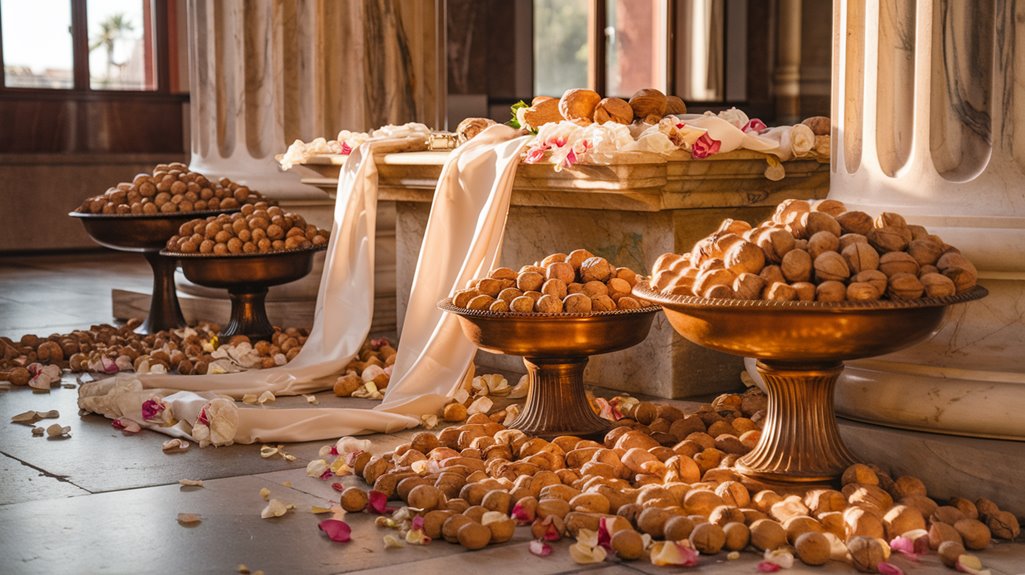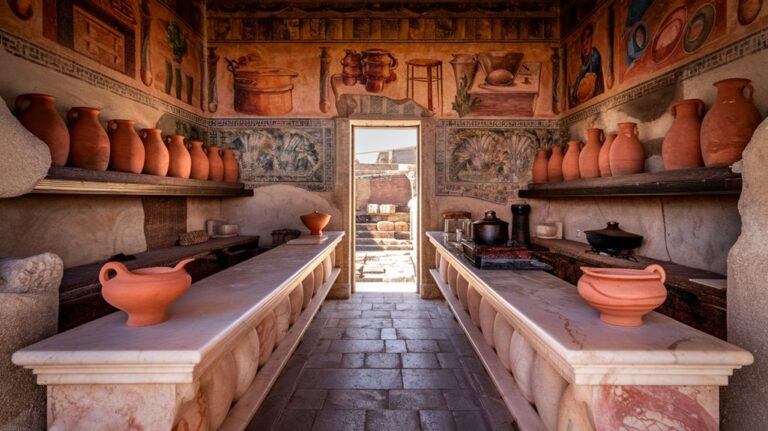Ancient Romans Threw Walnuts at Weddings
You might think throwing rice at weddings is an old tradition, but ancient Romans had a more dramatic approach – they hurled walnuts. This peculiar custom wasn't just for show; it carried deep symbolic meaning in Roman society. When you consider how these hard-shelled nuts represented fertility, prosperity, and a man's passage into married life, you'll discover there's more to this practice than meets the eye. What made walnuts so special in Roman wedding ceremonies?
The Sacred Symbolism of Walnuts in Roman Marriage

Walnuts held deep spiritual significance in ancient Roman wedding ceremonies, serving multiple symbolic purposes that reflected the culture's values and beliefs.
You'll find that these nuts were deeply woven into fertility beliefs, as Romans considered them powerful symbols of fruitfulness and successful marriages. When thrown during ceremonies, they weren't just decorative – they served as ritual offerings to Jupiter, the supreme deity. The Greeks and Romans also used these sacred nuts combined with honey for healing various ailments.
The practice carried meaningful changes, too. When a groom tossed walnuts, he symbolically marked his passage from boyhood to manhood, leaving childish things behind. The public procession's bawdy songs accompanied the ceremonial nut-throwing as the bride moved to her new home.
Even the sound of walnuts hitting the ground wasn't without meaning – Romans interpreted it as a favorable omen for the couple's future. This ancient Greek-inspired tradition eventually influenced wedding customs throughout Europe.
Wedding Processions and Rituals in Ancient Rome
While marriage customs varied across the Roman Empire, elaborate processions and rituals marked every wedding celebration.
You'd find the bride dressed in a long white robe, complete with a bridal veil and bright yellow shoes, while the groom typically wore a clean toga for the occasion. Participants in the procession would shower the couple with nuts and walnuts, believed to bring fertility and prosperity.
The public procession, known as deductio in domum mariti, began at the bride's home after the exchange of vows. Before departing, religious auspices were consulted to ensure favorable omens for the marriage.
Anyone could join this festive parade as it moved through the streets. Three boys would escort the bride, with one carrying a wooden torch called the Spina Alba, which had been lit at the bride's hearth.
Upon reaching the groom's house, you'd witness the bride being lifted over the threshold to avoid stepping on it, as this was considered sacred to Vesta.
From Greek Origins to Roman Wedding Traditions
As Roman civilization flourished, it embraced and adapted numerous Greek wedding customs, creating a rich tapestry of marital traditions. You'll find Greek influences in nearly every aspect of Roman wedding ceremonies, from the removal of the bride's veil to the symbolic use of nuts during processions.
The Romans incorporated many Greek rituals while adding their own unique touches. They maintained the practice of making sacrifices to deities, though they worshipped Juno instead of Artemis. Like their Greek predecessors, they viewed marriage as a means for producing strong children for the state. Evil spirits were warded off by having attendants dress similarly to the couple during ceremonies.
You'll notice similarities in how both cultures formalized marriages through ceremonial house processions and shared an emphasis on fertility symbols. Even the pre-wedding ceremonies show clear connections, with the Roman domum deductio closely resembling the Greek proaulia.
These adaptations showcase how deeply Greek customs shaped Roman wedding traditions.
The Role of Family and Consent in Roman Marriages
Roman marriage customs extended far beyond ceremonial rituals, centering on complex family dynamics and legal requirements. You'd find the pater familias wielding considerable authority, arranging marriages to forge political and economic alliances between families.
While he held this power, both the bride and groom needed to give their consent for the marriage to be valid. During betrothal, fathers were required to secure consent from children as young as seven years old.
The significance of consent in Roman marriages was multifaceted. You couldn't get married without approval from all parties involved, including the fathers of both families.
Particularly, a daughter could reject a proposed match if she could prove the suitor's poor character. Women maintained certain rights within these family dynamics, keeping their birth names and control over their dowries, even though they were expected to show deference to their fathers. Girls had to be at least twelve years old to legally marry, which was considered the age of consent.
Marriage Customs That Shaped Roman Society

Through elaborate rituals and customs, marriage ceremonies in ancient Rome served as public spectacles that reinforced social bonds and family alliances.
Beyond marriage contracts and dowry expectations, you'd witness a complex array of traditions that shaped Roman society. The union required consent from both parties to be considered valid under Roman law. Many noble girls were betrothed by twelve, reflecting the emphasis placed on early marriage for political alliances.
The ceremony itself featured distinct customs that symbolized the shift of the bride into her new family:
- The domum deductio, where the bride was ceremonially "kidnapped" from her home
- The sharing of fire and water at the groom's house
- The ritual of carrying the bride across the threshold
You'd see the bride adorned in a special dress, complete with a Hercules knot belt and yellow hairnet, while guests threw nuts and fruit to guarantee fertility.
These customs weren't just ceremonies – they were public declarations that united families and strengthened Rome's social fabric.










